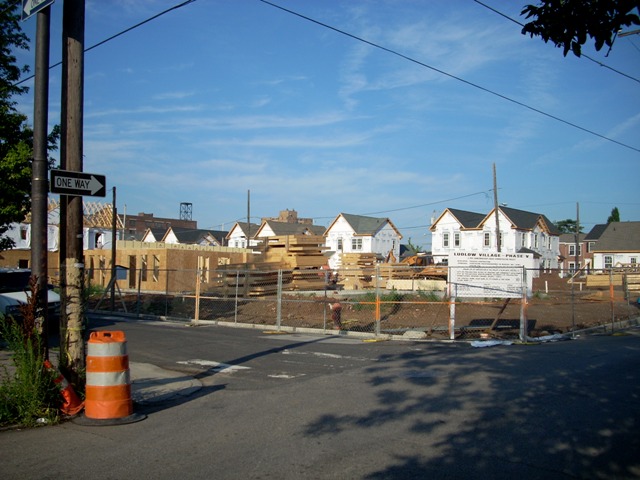Bacon students design to “rebuild and revive”

Aug. 4
By Thomas J. Walsh
For PlanPhilly
The Third Annual Ed Bacon Student Design Competition kicked off today, organized by the Ed Bacon Foundation, a nonprofit focusing on education efforts related to urban planning and development.
The competition this year, called “Rebuild │Revive,” will focus on the Ludlow neighborhood of lower North Philadelphia, with the boundaries set as Girard Avenue, Ninth Street, Cecil B. Moore Avenue and Fifth Street. It is an intentional departure from last year’s higher profile project, which centered on how to better position the Market East area.
“After last year’s competition, we made some adjustments to try and get more student entrants and to get more schools interested in incorporating it into their curriculum,” said Greg Heller, president of the Bacon Foundation and a planning and a design analyst at the Delaware Valley Regional Planning Commission. “This year we felt it would be much more relevant to try and tackle some of these tough, community-based problems.
Ludlow, which most Delaware Valley residents have never set foot in, has been battered by on-again, off-again urban renewal programs since the late 1940s. In the ’50s, Heller explained, with a shift away from predominantly African-American neighborhoods to fringe areas like Society Hill, Ludlow was neglected, only for it to be the test case for “scattered site housing” in the ’60s. (For an eye-opening aerial view of Ludlow’s barren urban landscape, take a look at this pdf image from the contest’s web site: http://www.edbacon.org/rebuild/images/2008_Bacon_Foundation_ortho_map.pdf).
“It really failed because the [Philadelphia Housing Authority] didn’t have the budget to maintain” the housing stock, said Heller (who is also writing a biography on Bacon, to be published by the Urban Land Institute). “As a result, L&I had to tear a lot of them down.” At the same time, the city’s population started to drain and a national trend of disinvesting in inner-city neighborhoods took hold. This competition is one that Bacon would have loved to oversee, the organization decided – he was at the helm of the Planning Commission throughout it all.
“You look at Ludlow today it has the same problems as it had in the ’60s,” Heller said. He contrasted it with another neighborhood of North Philadelphia, east of Broad, which also targeted middle-income blacks and was a success: Yorktown, which thrives today. The difference lay in the smart community planning that took place there, along with the commitment of a single developer.
Ludlow is also a timely subject, as new construction, the result of efforts of community development corporations in partnership with local and federal agencies, is under way. “These recent developments are not without their drawbacks, however, the starkest of which is a severe reduction in density and a suburban building pattern,” the foundation’s web site explains. “Many blocks newly developed seem suburban. Driveways outnumber pedestrians. Once the new houses are occupied, the neighborhood will still lack adequate recreation facilities, commercial activity, and educational resources to support new residents.
“This new construction will hardly make a dent in a sea of vacant blocks and parcels, dotted with crumbling older homes – reminders of a historic architectural aesthetic that has all but disappeared. There is neither an existing neighborhood plan, nor a functional citywide comprehensive plan to guide Ludlow’s contemporary development. It will take fresh thinking and true vision to rebuild and revive this disinvested community.”
Growing the contest
Other differences with this year’s competition are a broadening of the advisory committee to include people from outside the Bacon Foundation’s Board of Directors, and a change in timing.
Planning professors and department heads from Temple University and the University of Pennsylvania are involved more this year, and Heller said Temple has committed to making the contest part of its curriculum, a fact that will almost certainly help with another goal, increasing the number of entrants.
The shift in timing from an April start date was meant to facilitate that kind of school involvement, Heller said, and the effort is starting to gain attention nationally. The organization sent more notices this year to the top university planning programs in the country. Launching the competition in early August was meant to give students some time before classes begin to formulate ideas and teams. Entries are due October 31.
Last year’s winners, announced in November (http://www.planphilly.com/node/2189), were five students from the Boston Architectural College, whose presentation was a reimagining of Market East as a series of buildings with residential and retail space, a nightclub, currency exchange and passport office. The idea was to make the space into a multicultural center within a redesigned infrastructure, to include taking the city’s main bus terminal underground.
Three teams from Temple and Drexel University earned honorable mention.
Contact the reporter at thomaswalsh1@gmail.com
Contest site: http://www.edbacon.org/rebuild/index.htm
WHYY is your source for fact-based, in-depth journalism and information. As a nonprofit organization, we rely on financial support from readers like you. Please give today.



